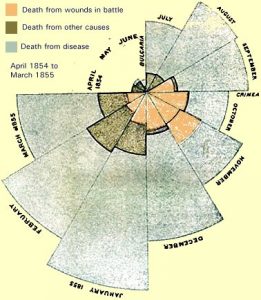Picture this: a mid-1850s hospital, dirty, covered with bacteria and disease. Doctors running around trying to take care of as many patients as possible, all while medicine isn’t very up to date. The struggle for healthcare in the 1850s was severe, and people were constantly needing help. Florence Nightingale saw this and acted. Although it was challenging, and she continually faced pushback from peers and coworkers, she persevered and managed to create a lifelong legacy.

Florence Nightingale was born in 1820 to a wealthy British family with access to education and travel. As she traveled, she noticed that the hospitals were dirty and overcrowded. She wanted to help change that. She believed that this was part of the reason nursing was her divine mission.1 Nightingale saw the hospitals filled with suffering people and identified areas for improvement, so she traveled extensively throughout Europe to study hospitals. Nightingale, coming from a wealthy family and being a woman during the Victorian era, was discriminated against by hospital workers and even by patients, saying that she was a woman and wasn’t cut out for the job. On the other hand, her family was against her becoming a nurse. They would tell her that she shouldn’t work as a nurse in the filthy conditions of the hospitals. Little did those people know that she was going to change the game for nurses.2
In 1854, the Crimean War was in full motion. Nightingale and 38 other volunteers set off to take care of wounded soldiers from the Crimean War. Once Nightingale arrived at the battle scene, it was filthy and overcrowded, and medicine wasn’t being provided fast enough to the patients. This reminded Nightingale about her observations at the hospitals around Europe. The soldiers themselves would lie in filth, the water was contaminated, and there were little to no medical supplies to treat injuries. According to the National Army Museum Article, the death rate for soldiers in the early stages of the war was 40%. Nightingale saw this and immediately started to clean, organize, and take charge of the medical tents.3
Nightingale would work tirelessly day and night to assure the soldiers that they would get treatment. She worked so hard that she gained the nickname, “The Lady with the Lamp.” This became her name because she would make her rounds at night, holding a lamp to check on patients. While making sure the wounded soldiers were taken care of, she also managed to create systems for organizing, record keeping, and cleaning the medical areas.4 Nightingale strongly emphasized the need for clean water, proper ventilation, and fresh air. She helped implement better ventilation in the medical wards and made sure the drainage would be better to reduce the amount of moisture and bacteria that would collect in the wards.5 Along with cleaning, she implemented hand washing rules and maintained the cleanliness of their person. As for patient care, regularly cleaning the wounds and the patients themselves, while also changing the environment around them, was a part of Nightingale’s new implementations for patients. 6 Along with the cleaning of rooms, Nightingale realized that a huge part of the patients’ recovery was due to their environment around them. Her “Environmental Theory” talks about how lighting and noise can affect a patient’s mindset for healing and resting, while also removing harmful elements that can dampen the healing process. 7

With new health systems helping to keep the wards clean, nutrition and food for the patients were also provided. Nightingale helped establish and organize a kitchen that would prepare the proper meals for the patients to give them the nutrition that they needed to successfully heal. She also paid attention to patients’ diets and allergies, which helped prevent future medical situations. Along with the preparation of meals, portion distribution established a balanced diet for each patient. 8 She would mark all this down in the patient’s records. Nightingale started an organized system for charting with diagrams, personal information, and visual statistics on the patients, while also maintaining an organized set of medical records. This was also beneficial to the nurses. She quickly gained support not only from the patients but the nurses working with her.9
With this new support that she gained, she started to put her plan of reform into action. At least, until the pushback and criticism started. The doctors in the wards were males, and they looked down on Nightingale and her fellow nurses. They continuously doubted her leadership and resented her authority. They made her job incredibly difficult as they would constantly try to complicate her situation. Along with the complications, she and the other nurses would face sexism and major criticism of her newly implemented systems. Despite all this, Nightingale continued her work calmly, and her focus remained on building reform. The support she gained helped her overcome the criticism, and she kept pushing forward.10

As sanitation, nutrition, and organization began to improve, the death rates also decreased. They dropped from 40% to about 2% within the months after Nightingale had implemented the new systems. With this success, people noticed that they liked the British Government. 11 With this recognition, not only did people realize what she was capable of, but she herself realized she could use her methods more broadly and not just for one hospital. The first thing Nightingale did after making this realization was to start writing detailed statistical reports to persuade parliament to adopt her sanitation reforms. 12 According to Red Cross UK, “She established the principles of patient care, health, and hygiene that influenced hospitals in future wars.” Something that specifically caught people’s eye was her use of “Coxcomb” diagrams.13
Word spread quickly, and soon, almost every newspaper had Florence Nightingale’s name in it. The public saw Nightingale both as compassionate and scientific; she led with her reason and emotion. With all this fame, not only did it make her methods more popular and widely used, but it also pushed her reform fast through hospitals. It reached almost every hospital in Britain at the time. Even though her success was in full swing, her own health took a turn for the worse.14 In May of 1855, Nightingale came down with a severe case of “Crimean Fever” or what is now known as Brucellosis. She became mostly bedridden due to her extreme fatigue and pain. Not only was Nightingale dealing with physical pain, but also mental and emotional strain. The constant stress led to burnout and depression, but despite all this, she did what she could from her home.15

While bedridden and ill, Nightingale’s proposals made it through to parliament and successfully led to reforms in the Army Medical Department, and helped improve the conditions for soldiers. During this time, she became an advisor to government officials. She helped make the needed improvements to health standards and helped enforce them. In 1857, the Nightingale Fund was created to help support her mission. 16 Donations from all over Britain help raise enough money to establish a nursing school. This school was founded at St. Thomas’ Hospital in London and was the first official nursing school in Europe. The school mainly focused on her methods of hygiene, compassion, discipline, and organization. Along with using her methods, her writings were translated and used around the world to better nursing today. 17
August 13, 1910 was the day the world lost a key character in the world of nursing. At the age of 90, Florence Nightingale died due to her illness. She began her journey as a disciplined and determined young woman and finished as a successful nurse who caused a reform that will never be forgotten. Through sexism, resistance, and horrible conditions, Nightingale managed to push through and continue to follow through on what she believed her mission to be. She has a broad impact that will remain relevant for years to come. 18
- Patrick Allitt, “Nightingale, Florence (1820–1910) | Encyclopedia.com,” in Nightingale, Florence (1820–1910). ↵
- “Florence Nightingale: The Lady with the Lamp | National Army Museum.” ↵
- “Florence Nightingale: The Lady with the Lamp | National Army Museum.” ↵
- Anonymous, “Florence Nightingale’s Story and Legacy,” British Red Cross, May 10, 2023. ↵
- Yana Turkowski and Victor Turkowski, “Florence Nightingale (1820-1910): The Founder of Modern Nursing,” Cureus 16, no. 8 (2024): e66192. ↵
- Richard Bates, “Florence Nightingale – a Pioneer of Hand Washing and Hygiene for Health,” Science Learning Hub, March 24, 2020. ↵
- Megan Kilpatrick, “Environmental Theory of Florence Nightingale,” WSNA, May 23, 2024. ↵
- “Florence Nightingale and the Crimean War | Research Starters | EBSCO Research,” EBSCO. ↵
- “Florence Nightingale: The Making of a Hospital Reformer – Lynn McDonald, 2020.” ↵
- Patrick Allitt, “Nightingale, Florence (1820–1910) | Encyclopedia.com,” in Nightingale, Florence (1820–1910). ↵
- Donald R. Allen, “Florence Nightingale: Toward a Psychohistorical Interpretation,” The Journal of Interdisciplinary History 6, no. 1 (1975). ↵
- Florence Nightingale and Her Crimean War Statistics – Professor Lynn McDonald, directed by Gresham College, 2014, 32: 38.” ↵
- “Florence Nightingale’s Story and Legacy, British Red Cross.” ↵
- “Florence Nightingale’s Story and Legacy, British Red Cross.” ↵
- Patrick Allitt, “Nightingale, Florence (1820–1910) | Encyclopedia.com,” in Nightingale, Florence (1820–1910).” ↵
- “Florence Nightingale: The Lady with the Lamp | National Army Museum.” ↵
- “Florence Nightingale’s Story and Legacy, British Red Cross.” ↵
- Patrick Allitt, “Nightingale, Florence (1820–1910) | Encyclopedia.com,” in Nightingale, Florence (1820–1910). ↵



5 comments
Robert Almanzan
Good job. Very informative and a good read. Keep up the good work.
Tracy Almanzan
Fantastic research paper on a historical figure that isn’t spoken about enough. Her legacy of compassion and perseverance still lives on in our wonderful nurses of today. Thank you for highlighting her story.
Sandra Sanchez Almanzan
Great article she was very talented and committed. Did not know her full story super educational. Well done.
Becky torres
Well written, information that as a nurse I did not know about Florence. Article was informative and focused on key points that were significant in history and medical history. Enjoyed reading the article.
Oscar Torres
Great article, from a long time nurse there were many facts in Mrs Nightingale that I was not aware of, simply was not aware why she is always pictured with the lantern, didn’t realize she was a night shift nurse like my self.